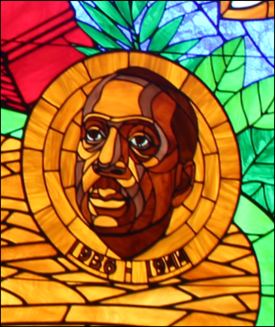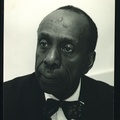It was as co-pastor of the Fellowship Church that Howard Thurman made his greatest contribution to working with Japanese Americans. As mentioned previously, it was in 1944 that Thurman was invited to join a white minister, Alfred Fisk, as co-pastor of the new church, which was one of the first churches in the United States organized on an intentionally interracial and interreligious basis. The assignment was sufficiently noteworthy that, on his departure from Howard in May 1944, Thurman was fêted at a gala in which the guest speaker, First Lady Eleanor Roosevelt, wished him success in the undertaking. Mrs. Roosevelt would remain a “national associate and donor” of the Fellowship Church.
Although ethnic Japanese, excluded from the West Coast and confined by official order, formed a rather ghostly presence in San Francisco at the time of Thurman’s initial arrival, the local Japanese community was critical to the history of Fellowship Church. The first home of the Church was the small Japanese Presbyterian Church in the prewar Japanese neighborhood dubbed “Little Osaka”. The Church was formed, in turn, with help from a group of young female college graduates who lived together in a Gandhian commune or “ashram.” Their collective was known as the Sakai group, because they lived together in a house formerly owned by a Mr. Sakai.
From its founding in early 1944, Fellowship Church was concerned with the plight of San Francisco’s Japanese Americans. One of the founding members of the church was Annie Clo Watson, leader of the International Institute of San Francisco, an offshoot of the YWCA. In addition to her efforts to win better treatment for Japanese Americans in the camps, she published an article on the subject, “Americans on the Fringes,” in the Journal of Educational Sociology.
By the fall of 1944, when Thurman’s wife Sue Bailey Thurman joined the Board of Directors of the International Institute, it was gearing up to help prepare for the return of the former inmates to the city. In May 1945, Sue Bailey Thurman likewise reported to The Chicago Defender on her work attending sessions of the San Francisco organizing conference of the United Nations, sitting in the “dress circle” of the San Francisco Opera House as a “national observer.” In repeating dialogue among observers about Japanese Americans, she took the opportunity to remind her readers about the 17,600 soldiers of Japanese ancestry fighting for the United Nations, especially the exploits of the 100th Battalion in Italy.
Beginning in January 1945, as exclusion was lifted and the WRA camps began to close, the former Japanese residents of San Francisco, plus others who had formerly lived in rural areas, started to trickle into the city in hopes of restarting their interrupted lives. The Fellowship Church made a special effort to welcome the returnees, holding a dinner in February 1945 for twenty-four Japanese Americans, who were the guests of honor at a dinner alongside 130 Fellowship Church members and friends. In June 1945, the church hosted Hugh E. Macbeth, an African American lawyer from Los Angeles who was deeply involved in the struggle for Japanese American rights, as the guest speaker on a Sunday morning.
As they returned, Japanese Americans soon became a crucial part of the Fellowship church. In March 1945, answering an urgent appeal of Thurman’s, the church hired Ayoka Murota, recently returned from the camps, as its secretary. Thurman would later write in his autobiography that a few months later, he held her hand, “from 8:30 in the morning until 2:00 in the afternoon while the tidings of Hiroshima were coming across the air. Her aunts, her uncles, her nephews were all there. Now and then, the grip of my hand would tighten on hers, or the grip of her hand would tighten in mine. There were no words for words were raspy noises, unuttered in the discipline that would make manifest what was stirring in our hearts.”
By the end of 1945, Dave Tatsuno, president of the San Francisco chapter of the Japanese American Citizens League (and later director of an award-winning film, Topaz, about his experience in camp) had joined the church’s board of trustees. Under his leadership, Thurman would write, “the Sunday school was largely Japanese-American with a few Caucasians and a few Negroes.”
Japanese American attendance declined over the next few years. Even as the Fellowship Church moved to a new building outside the Japanese district, the prewar Japanese churches re-opened, and many Japanese churchgoers chose return to their former congregations. Still, by 1948, according to an article in the Atlanta Daily World, a Sunday service held by Thurman drew “250 men and women of all races...Half the congregation was white, a third Negro, and the rest Japanese, Chinese, and Filipinos.”
One of Thurman’s strongest Japanese American connections was with John Yamashita, a Nisei Methodist minister. Even before moving to San Francisco, Thurman was already acquainted with the Yamashita family. John’s sister Kay had attended a race relations institute at Mills College in summer 1942 where Thurman was a guest speaker.
Then, in February 1945 John met up with Thurman in Ann Arbor, Michigan while travelling through the East. In 1947 and 1948, John Yamashita was engaged by the Fellowship Church as an assistant minister, preaching one Sunday per month.
In hopes of obtaining his services, Thurman wrote the following to a Methodist minister in May 1947:
Because of the general climate on the Pacific Coast that in some ways is not congenial to Japanese Americans, we are particularly anxious to provide an experience of complete integration within our religious fellowship on all levels of participation in what we are doing. It would be a very great thing if there were at least one church on the Pacific Coast in which these people shared the leadership and membership participation as a part of a fellowship of heterogenous people. I need not tell you that they have sustained a profound injury both spiritually and psychologically from which it is extraordinarily difficult for them to emerge with some measure of vitality and health as American citizens.
In her book Letters to Memory, the renowned writer Karen Tei Yamashita, John's daughter, described Thurman as her father's “friend and mentor.”
Thurman’s approach to this sort of dislocation, for African-Americans, for Japanese-Americans, for any minority group, was not to pity, nor to try to “help” from a position of authority and superiority, but to include them as equals, as is clear in this description of a meeting of a young adult group in the church from 1947:
An open fire cracked and popped. Hearthside rays glanced from an East
Indian reflected to the intense faces—the faces of young people in discussion—all young Americans—a Negro sailor from Chicago, a Nisei
girl, a native San Franciscan, a Caucasian from a southern state, a Filipino youth leader. . . . Questions, answers, opinions flew back and forth. Suddenly the mugs of cocoa appeared, the discussion drew to a close. . . . The whole group joined in laughter, song, and fun.
In August 1952, the old Booker T. Washington Community Center, a longstanding community center for African Americans which had moved into a former Japanese language school building during World War II, opened a new facility to be used as a community center by people of all races and creeds. Howard Thurman, presiding at the dedication, stated, “There is not a person here tonight who could hold a straight and honest face if we were dedicating a center—a community center—for one race at the exclusion of another. Since the First World War, the whole idea of people being separate has changed. And so tonight I am able to join with you of many races in opening a center for the whole community.”

Within a year after that night, Thurman left San Francisco and the Fellowship Church to take up a position as dean of chapel at Boston University, remaining in that position until his retirement in 1965. After his retirement he returned to San Francisco, where he maintained an active schedule of writing, preaching, and lecturing until shortly before his death in April 1981. His commitment to Gandhian nonviolence and social change influenced Dr. Martin Luther King, Jr. and other civil rights activists.
Apart from occasional visits with the Yamashitas, Thurman would have little direct contact with Japanese Americans in his later years. Yet he retained the spirit of his Fellowship Church, and spent his life trying to create a world community where different peoples and different religions would draw strength from their differences. In 1960 he visited Japan, where he connected with peace activists who were “opposed to anything that might portend a future Hiroshima for themselves, or mankind anywhere.” Thurman concluded his philosophical masterwork, The Search for Common Ground (1971) by saying that “community cannot feed on itself, it can only flourish where always the boundaries are giving way to the coming of others beyond them.”
© 2021 Greg Robinson; Peter Eisenstadt







